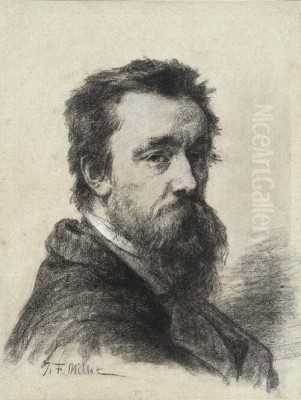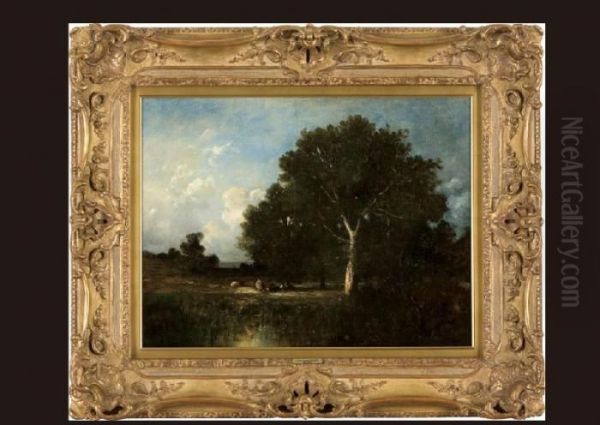
Léon Victor Dupré (1816-1879) stands as a significant, albeit sometimes overlooked, figure within the influential Barbizon School of French landscape painting. A dedicated observer of the natural world, Dupré carved his niche by depicting the serene beauty and quiet dignity of the French countryside, contributing significantly to the shift towards Realism in 19th-century art. His life and work, closely intertwined with his more famous brother Jules Dupré, offer a fascinating glimpse into the artistic currents that shaped modern landscape painting.
Born in Limoges in 1816, Léon Victor Dupré entered a world where artistic conventions were being challenged. While details of his earliest training are less documented than his brother's, it is almost certain that he benefited immensely from the artistic environment fostered by Jules. The Dupré family was involved in the porcelain industry, which often required artistic skill, potentially providing an early exposure to decorative arts and design for both brothers.
The move to Paris, the epicenter of the French art world, was a crucial step. It was here that Léon Victor would fully immerse himself in the burgeoning landscape movement and solidify his association with the Barbizon painters. Paris offered access to museums, salons, and, most importantly, a community of artists eager to break free from the constraints of Neoclassical historical painting.
Embracing the Barbizon Spirit
The Barbizon School, named after the village near the Forest of Fontainebleau where many of its proponents gathered, was less a formalized institution and more a collective of artists united by a shared philosophy. They advocated for painting directly from nature (en plein air, or at least making direct studies outdoors), capturing the transient effects of light and atmosphere, and finding beauty in the humble, everyday landscapes of rural France. This was a radical departure from the idealized, studio-bound compositions favored by the Academy.

Léon Victor Dupré became an integral part of this movement. He frequented the Forest of Fontainebleau and other rustic locations, absorbing the Barbizon ethos. His contemporaries and fellow travelers in this artistic endeavor included the leading lights of the school: Théodore Rousseau, known for his dramatic forest scenes; Jean-François Millet, celebrated for his dignified portrayals of peasant life; Charles-François Daubigny, a master of riverine landscapes often painted from his studio boat; Narcisse Virgilio Díaz de la Peña, who infused his woodland scenes with a touch of fantasy; and Constant Troyon, renowned for his depictions of cattle.
Dupré's work embodies the core tenets of Barbizon painting. He sought truthfulness in representation, meticulously observing the specific character of trees, water, and sky. His landscapes are imbued with a sense of place, capturing the particular light and atmosphere of regions like the Île-de-France, Normandy, and the Berry. He shared the Barbizon fascination with the interplay between humanity and nature, often including figures of peasants or animals to animate his scenes and emphasize the connection to rural life.
Artistic Style and Techniques
Léon Victor Dupré developed a distinctive style characterized by its sensitivity to light, refined brushwork, and tranquil mood. While clearly aligned with Barbizon Realism, his work often possesses a subtle poetic quality, a gentle lyricism that distinguishes it. He excelled at capturing the soft, diffused light of morning or late afternoon, rendering reflections in water with remarkable clarity and subtlety.
His technique involved careful observation translated through often delicate brushstrokes, particularly in rendering foliage and distant vistas. However, he could also employ a richer application of paint, building texture to convey the solidity of earth or the roughness of bark, showing an understanding of impasto techniques common among his peers. His palette was generally naturalistic, favoring earthy greens, browns, and blues, but he skillfully used variations in tone and hue to create depth and atmosphere.
Unlike the sometimes turbulent or dramatic canvases of his brother Jules, Léon Victor's works often evoke a sense of calm and stability. He frequently depicted peaceful riverbanks, quiet ponds (mares), rolling fields under expansive skies, and farmsteads nestled within the landscape. Water was a recurring motif, allowing him to explore the complexities of reflection and transparency, adding a luminous quality to many of his compositions.
The Brothers Dupré: A Shared Path
The artistic relationship between Léon Victor and his older brother, Jules Dupré (1811-1889), is central to understanding his career. Jules was one of the most prominent and successful members of the Barbizon School, known for his powerful, often dramatic landscapes influenced by Romanticism and painters like John Constable. The brothers were exceptionally close, frequently traveling and painting together, particularly along the rivers Oise and Marne, and in the L'Isle-Adam region where Jules eventually settled.
This closeness led to a degree of stylistic similarity, especially in certain periods, making attribution occasionally challenging for art historians. Both brothers shared a deep love for the French countryside and a commitment to capturing its essence. However, subtle distinctions often emerge upon closer examination. Jules's work frequently features more dramatic compositions, bolder contrasts of light and shadow, and a more vigorous, sometimes turbulent, handling of paint, reflecting a stronger Romantic impulse.
Léon Victor, while equally skilled, often favored calmer scenes, a more detailed finish, and a gentler atmospheric envelopment. His friend and art dealer, Amédée Besnus, described him as perhaps more reserved than Jules but possessing a keen intellect, enthusiasm, and a sharp sense of humor. Despite living somewhat in the shadow of his brother's greater fame, Léon Victor maintained a consistent presence, exhibiting his works at the Paris Salon, though perhaps less frequently than Jules. His paintings were appreciated by collectors and critics for their sincerity and technical accomplishment.
Key Works and Enduring Themes
Several works stand out as representative of Léon Victor Dupré's artistic achievements. La Mare (The Pond), dating from around 1865, exemplifies his skill in rendering tranquil water scenes. It likely depicts one of the many small ponds found in the forests or fields he frequented, capturing the reflections of trees and sky with delicate precision and a masterful handling of light.
Paintings often titled generically, such as Farmhouse in the Countryside or Rural Homestead, showcase his interest in the integration of human habitation within the natural environment. These works typically depict modest farm buildings, often with figures engaged in daily activities, set against a backdrop of fields, trees, and sky. They convey a sense of harmony between humanity and nature, a common Barbizon theme.
Figures by a River, dated 1879, the year of his death, demonstrates his continued focus on riverine landscapes. Such scenes allowed him to explore the movement of water, the play of light on its surface, and the peaceful coexistence of figures within a serene natural setting. Other common subjects included cattle watering at riversides or resting in pastures, themes also explored by contemporaries like Constant Troyon and Rosa Bonheur. These works highlight his keen observation of animal forms and their natural integration into the landscape.
Throughout his oeuvre, the recurring themes are the quiet beauty of the French countryside, the effects of natural light and atmosphere, the importance of water in the landscape, and the simple dignity of rural life. His works invite contemplation and offer a peaceful respite, reflecting a deep and abiding connection to the natural world.
Influences and Connections
Like many artists of his generation, Léon Victor Dupré drew inspiration from various sources. The Dutch Golden Age landscape painters of the 17th century, such as Jacob van Ruisdael and Meindert Hobbema, were significant precursors for the Barbizon artists, admired for their naturalism and focus on native scenery. Their influence can be seen in the structure and atmospheric depth of Dupré's compositions.
Equally important was the impact of English landscape painting, particularly the work of John Constable, whose paintings caused a sensation when exhibited in Paris in the 1820s. Constable's fresh, direct approach to nature, his study of changing skies, and his textured brushwork profoundly influenced the development of French landscape painting, including the work of both Dupré brothers. The luminous watercolors of Richard Parkes Bonington and the atmospheric drama of J.M.W. Turner also contributed to the broader artistic climate that nurtured the Barbizon School. The Norwich School painter John Crome, with his faithful depictions of the English countryside, represents a parallel development focused on localized naturalism.
Within the Barbizon group itself, there was constant interaction and mutual influence. Dupré would have undoubtedly learned from and exchanged ideas with Rousseau, Daubigny, Millet, and others, contributing to the collective exploration of landscape representation. His own dedication to careful observation and light effects reinforced the central aims of the school.
Personality and Recognition
While perhaps less flamboyant than some of his contemporaries, Léon Victor Dupré was respected within the artistic community. The description provided by Amédée Besnus paints a picture of an intelligent, observant, and engaging individual. His "unbiased, enthusiastic, and humorous" nature suggests a personable character, capable of sharp and insightful commentary.
His regular, if not prolific, participation in the official Paris Salon ensured his work was seen by the public and critics. While he may not have achieved the widespread fame or official accolades of his brother Jules or figures like Rousseau, his paintings found favor with collectors who appreciated their quiet beauty, technical skill, and sincere depiction of nature. His works entered private collections and continue to be sought after today, appearing in galleries and at auction. The enduring appeal lies in their authentic representation of the Barbizon spirit.
Legacy and Lasting Influence
Léon Victor Dupré's primary legacy lies in his contribution to the Barbizon School and its revolutionary impact on landscape painting. Alongside his brother and colleagues, he helped shift the focus of art from idealized historical or mythological subjects towards a direct engagement with the observable world. Their emphasis on painting outdoors, capturing specific light conditions, and finding beauty in ordinary nature laid crucial groundwork for the next major movement in French art: Impressionism.
While not an Impressionist himself, Dupré's sensitivity to light and atmosphere, his nuanced color palettes, and his commitment to capturing the visual sensations of a particular place and moment anticipate Impressionist concerns. Artists like Claude Monet, Camille Pissarro, and Alfred Sisley, who took the principles of plein air painting and the study of light even further, owed a significant debt to the pioneering efforts of the Barbizon generation.
Vincent van Gogh, though belonging to a later generation with different expressive aims, deeply admired the Barbizon painters, explicitly praising Jules Dupré as a towering figure. This admiration extended to the entire school's dedication to nature and their elevation of landscape and peasant themes. Léon Victor Dupré, as a dedicated practitioner of the Barbizon ethos, played his part in this important lineage.
In conclusion, Léon Victor Dupré was a talented and sensitive painter who made a valuable contribution to 19th-century French art. As a key member of the Barbizon School, he excelled in capturing the tranquil beauty and specific atmosphere of the French countryside. Working closely with his brother Jules, yet maintaining his own distinct, often gentler voice, he created landscapes characterized by fine observation, skillful handling of light, and a deep appreciation for the natural world. His work remains a testament to the enduring power of landscape painting and the revolutionary spirit of the Barbizon artists who paved the way for modern art.